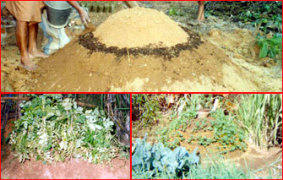Name : Lingaraj Pradhan
District & State : Sundargarh, Orissa
Category : Utility
Award : Consolation
Award Function : 3rd National Grassroots Innovation Awards
Award Year : 2005
Innovation Description
 Lingaraj Pradhan (64) hails from Jakeikala, Sundargarh district in Orissa. He is a matric trained certified school teacher who taught Oriya language, English, Maths and science. His family consists of his wife and two sons. His elder son is a social worker. The younger son is self employed and runs a small rice mill. His sons also help him in cultivation and his family has supported him in all his endeavours. A self motivated man he also tries his hand at repairing agricultural implements and other machinery at home.
Lingaraj Pradhan (64) hails from Jakeikala, Sundargarh district in Orissa. He is a matric trained certified school teacher who taught Oriya language, English, Maths and science. His family consists of his wife and two sons. His elder son is a social worker. The younger son is self employed and runs a small rice mill. His sons also help him in cultivation and his family has supported him in all his endeavours. A self motivated man he also tries his hand at repairing agricultural implements and other machinery at home.
Genesis
After teaching in a school for 38 years, Lingaraj has been pursuing his interest in gardening after his retirement. About four years ago he started thinking about using the limited land surface available for agriculture with greater efficiency by growing more plants on less land and thus came up with the idea of cultivation of potato in hay packets. He first implemented this idea in 1999-2000 in a small hay made packet. At first he could not make the perfect hay made packet. But with continuous efforts he succeeded and now he is doing the same repeatedly with success.
The method developed by Lingaraj consists of cultivating potato in sacks made from the ropes of paddy hay. Like knitting a bamboo basket, a packet of hay is prepared in which mounds of soil and compost are put. The mound of earth in this hay pack is kept in place with the help of hay ropes.
These hay made packets are called ‘Pura’, ‘Puruga’ or ‘Olia’ in the local dialect. These hay made packets are generally made by farmers to store seeds and grains in villages. Now Pradhan is using this technique for potato cultivation.
Lingaraj has modified these hay sacks for potato cultivation by filling these packs with soil, cow dung and compost and binding them with ropes. In between two adjacent ropes made of hay, at the periphery of the packets, pre-prepared potato buds are placed. Leaves of the young plant come out from the junction of two ropes and the roots spread into the soil inside the packet. For watering these plants, he reuses water that has been used for domestic use. The crop takes the same time to mature in the hay packs as in the farm. Lingaraj now proposes to keep these packs on wheeled iron racks, one over the other, so that they can be put in the sun easily.
Advantages
This method of cultivation is a boon for landless farmers especially as it needs no land and reuses water. Other points in its favour are the fuller utilization of natural fertilizers. Labour is saved in weeding since there are practically no weeds and hardly any need for pesticides. Each sack gives a yield of about 10 to 15 kilograms.
Recognition…
Lingaraj has not sought publicity for his practice or any help from government agencies but those who have heard of it and visited his garden, are full of appreciation and it is currently being practised in four nearby villages. He acknowledges that his peers and villagers have fully supported him. This innovation had been featured in the weekly Gramin Sambad and the daily Pragatibadi.
http://nif.org.in/innovation/Potato_Cultivation_in_Hay_Sacks/250
